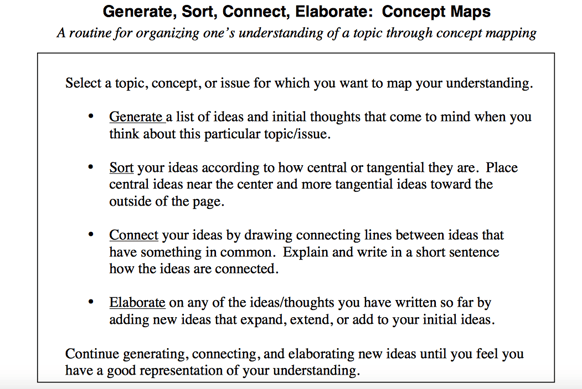The Harvard Graduate School of Education’s Project Zero defines Visible Thinking as “a flexible and systematic research-based conceptual framework, which aims to integrate the development of students' thinking with content learning across subject matters.” The Project has distilled this framework into several thinking routines that are simple protocols for exploring ideas and make students thinking visible. Teachers are encouraged to integrate these routines into daily classroom life and use them with their students to extend and deepen their thinking. These easy-to-learn mini-strategies are focused on four "thinking ideals" – understanding, truth, fairness, and creativity.
Generate-Sort-Connect-Elaborate (GSCE) is a thinking routine for students to organize their understanding. This routine uses concept maps as a means for students to activate prior knowledge, generate ideas about a topic and make connections among these ideas. Importantly, this routine encourages maps to be used progressively, having students modify their maps over time as they continue to extend and deepen their understanding of a topic.
Using Ideaphora Classroom, educators can empower students to become experts in curriculum topics while developing their thinking skills and awareness. Following the GSCE protocol, teachers can instruct students at the outset of a unit to brainstorm and organize their existing knowledge of the topic in the Ideaphora concept mapping canvas. Teachers can assign resources from Ideaphora’s library – vetted open education resources as well as materials they upload – for students to read or watch and use in their maps. Ideaphora's semantic analysis gives students a head start by pre-identifying key concepts from the resources that can easily be dragged and dropped into their maps. As students review the resources, they assimilate key information on the topic and modify their maps accordingly, revealing their deeper level of understanding and more complex thinking.
The goal of Visible Thinking is to help students develop habits of mind and build dispositions toward thinking by immersing students in classrooms where thinking is valued, visible and actively promoted. Not only do students need to be skilled in thinking but also alert to thinking and learning opportunities and eager to pursue them, knowing when and what strategies are appropriate to apply.
Through their research, Harvard researchers found concept mapping not only made students’ thinking visible, it also increased students’ awareness and control over their own thinking. Their investigations revealed concept maps are “rich vehicles for uncovering students’ conceptions of thinking in a way that is accessible both to teachers and students.” To study students’ conceptions of thinking, they used concept mapping as a measurement tool. Their reasoning shows its multifaceted benefits and flexibility in the classroom. They stated concept maps were authentic to classroom learning and would not feel like a test, fostered discussion, encouraged open-ended responses rather than right or wrong answers, and were transparent so that teachers could see themselves as researchers into their students’ thinking.
Ideaphora Classroom enables educators to create a culture of thinking in their classrooms and schools. And, the thinking dispositions and skills they instill in their students will extend well beyond the school walls and far into the future when these learners become leaders. We'd love to hear how you've used concept mapping to investigate students' thinking and develop their habits of mind. Contact us at info@ideaphora.com.

